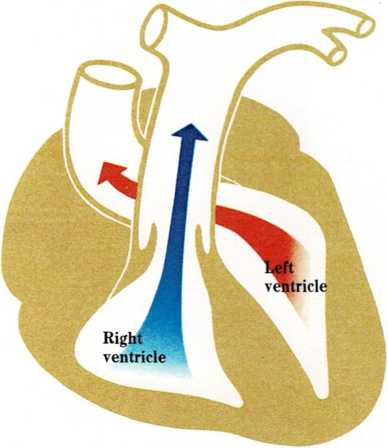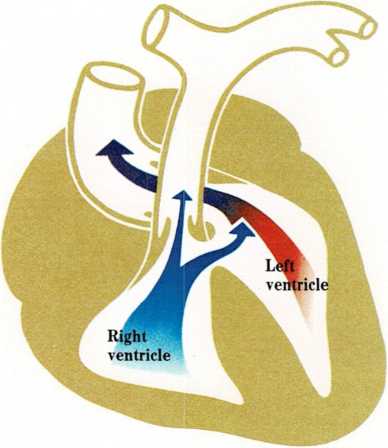Cyanosis – Cysts
Cyanosis is a bluish coloring of the skin and lips that results from
a lack of oxygen in the blood. A “blue baby” has cyanosis because a
congenital (present at birth) heart defect interferes with the
circulation of blood through the heart. Cyanosis in a blue baby is not
always apparent when the baby is resting, but it may become noticeable
when the baby cries or is very active. In addition to cyanosis, the baby
may also have a heart murmur and respiratory problems.
Congenital heart defects. Cyanosis due to congenital heart defects
is usually caused by
A normal heart and an abnormal heart

Normally, the right ventricle pumps blood to the lungs, where oxygen
is added. The blood then flows back into the heart, and the left
ventricle pumps it to the body.

In this heart, much of the blood flows through a hole in the wall
between the ventricles and by-passes the lungs. The left ventricle
then pumps it to the body.
the passage of unoxygenated, bluish blood fi’om the veins through an
abnormal opening in the wall between the right and left ventricles of
the heart. This defect is called a Ventricular Septal Defect (VSD). In a
normal heart, the unoxygenated blood from the veins is pumped from the
right ventricle through the pulmonary artery to the lungs, where oxygen
is added. Then, the bright red, oxygenated blood is pumped into the left
ventricle and into the aorta and other arteries. In a child with
cyanosis caused by a congenital heart defect, part or all of the blood
by-passes the lungs. Because of an abnormal opening between the
ventricles, the unoxygenated blood is pumped from the right ventricle
directly into the left ventricle, and then into the aorta.
In addition to an abnormal opening between the left and right sides of
the heart, there may be an obstruction or narrowing of the pulmonary
artery. This obstruction or narrowing also prevents the blood from being
properly oxygenated.
Another congenital heart defect that causes cyanosis is transposition
(change in the position) of the aorta and the pulmonary artery. Cyanosis
may also indicate that the baby’s heart has only one ventricle.
If your baby has a congenital heart defect, your doctor will probably
refer you to a pediatric cardiologist (a children’s doctor who
specializes in the treatment of the heart and its diseases). The
cardiologist will take a chest X ray and an electrocardiogram (EKG),
which records the size and shape of the electrical impulses of the
heart. This doctor may examine the heart by echocardiography and cardiac
catheterization. A long tube is inserted in the heart through a vein in
the arm, and the path of the tube is viewed on an X-ray screen. The
cardiologist may also introduce a dye into the baby’s circulation to
help temporarily outline the defect.
Some heart defects can be corrected by surgery, but the timing of the
operation depends on the baby. As long as the baby is gaining weight and
does not have severe breathing difficulty, the operation will probably
be delayed until the baby is 2 years old. Corrective operations include
by-passing the narrow passage that impedes the flow of
blood to the lungs and closing off the abnormal opening between the
right and left sides of the heart. Many congenital defects can be
completely corrected so that the child has no disability.
Other causes. Cyanosis can also be caused by a collapsed lung,
pneumonia, suffocation, shock, or other conditions. Treatment consists
of relieving the condition that is producing the lack of oxygenated
blood, and, if necessary, giving the child oxygen, [m.g.]
Cystic fibrosis is an inherited disease in which glands produce
abnormally thick mucus that clogs up body organs and hinders their
normal operation. Breathing and digestion are most often affected.
Doctors do not know exactly what causes it or how to cure it completely.
Early diagnosis and treatment have made it possible for many affected
children to lead fairly normal lives until they are adolescents or young
adults.
The most common and serious symptoms of cystic fibrosis are a
persistent, hacking cough and repeated attacks of bronchitis or
pneumonia. These are caused by blocked air passages. Some newborn babies
who have cystic fibrosis may have difficulty with bowel movements
because of an obstruction in the intestines. These infants may have
frequent bowel movements that are bulky, loose, pale, and unusually
foul-smelling. They may fail to gain weight even though they have a good
appetite. A child with cystic fibrosis loses an excessive amount of salt
through sweat.
If the disease has settled in the respiratory tract, your doctor may
prescribe regular aerosol treatment through a face mask to help thin out
the secretions in the child’s breathing passages so that mucus can be
brought up to the throat, and the child can spit it out. The child may
also receive antibiotics or drugs that relax the chest bronchial
airways.
The doctor may also prescribe physical therapy to promote draining of
the secretions from the bronchial tubes.
The doctor generally prescribes a diet high in protein and calories. In
the presence of abdominal cramps or frequent, oily stools, a diet
moderately low in fat content may be
recommended. Because pancreatic juices necessary for digestion become
blocked in the pancreas, pancreatic enzyme preparations may have to be
given by mouth. [m.c.]
Cysts are abnormal, fluid-filled sacs within the body. A cyst has no
opening. Usually the lining of the cyst produces the material that fills
the cyst.
Cysts are of all sizes and may occur almost anywhere in the body. They
may be congenital (something the child is born with), or they may result
when a gland opening becomes plugged. Sometimes, doctors cannot
determine their cause. Only rarely are cysts malignant.
Some cysts are simple and harmless. They eventually disappear by
themselves. Often, however, cysts have to be removed. Some, such as a
thyroglossal cyst (in the neck), tend to become infected. Other cysts
have to be removed because they interfere with proper functioning of a
body organ. For example, cysts on the lungs may interfere with
breathing.
Cysts that are close to the surface of the skin can be removed by simple
surgery in the doctor’s office. Cysts that are deep in the abdomen or
chest require a major operation and hospitalization,
[t.m.h.]

